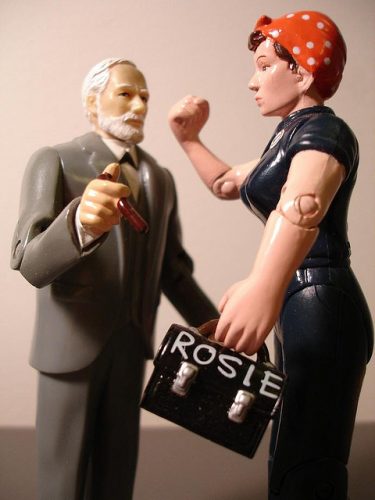Hiding Out or Moving On?
‘Why are we all here?’, Juliet Mitchell asks her audience, rhetorically. She is opening a conference in London held in May to mark the twentieth anniversary of the publication of her book Psychoanalysis and Feminism. ‘Why are we all here, and not there – as feminists, that is – in the world, in the field? What is the attraction of psychoanalysis?’ But is she serious? None of the speakers, or the audience, really seemed to think so. The answer was all too obvious. We were ‘here’ – part of the ever more self-enclosed and politically detached intellectual culture of British feminism – because we did not want to be out ‘there’, in a defensive struggle to fight off further erosions in the living standards of the bulk of women. In these unpropitious times, who would?
Mitchell went on to explain that her book was written from neither a clinical nor a directly theoretical need, but rather with the strictly political aim of assessing the limitations of Marxism for understanding the situation of women. When it came to explaining the depth of patriarchy and the difficulty of eroding it, there seemed to be some absolute difference – more entrenched than any other social division – which only psychoanalysis could address through its account of the unconscious construction of sexual difference. Other speakers, while pointing to some of the limitations of psychoanalysis (especially in its pathologising approach to lesbians and gay men), all agreed on one thing: that the theoretical promise of psychoanalysis for feminism lay in its challenge to any proclaimed certainties, any normative theorising, about what it means to be a ‘woman’. Margot Waddell even felt able to declare: ‘To think psychoanalytically is, in my view, to think as a feminist too.’
 As if in instant mockery of this promise, however, certainties and normativities returned like the repressed in the very next session – ushered back in by the feminist appropriation of ‘object-relations’ theory. Carol Gilligan’s clinical work led her to conclude that all girls face a ‘relational crisis’ as they enter adolescence, recognising that they must suppress their former, deeply internalised ‘feminine’ and nurturing concerns and instead assert more autonomous selves Speakers from the floor relaxed back into a familiar therapeutic knowingness: ‘girls always have problems outside caring relationships’; ‘it is rare to find a man who embodies the feminine ethic of care’, etc, etc.
As if in instant mockery of this promise, however, certainties and normativities returned like the repressed in the very next session – ushered back in by the feminist appropriation of ‘object-relations’ theory. Carol Gilligan’s clinical work led her to conclude that all girls face a ‘relational crisis’ as they enter adolescence, recognising that they must suppress their former, deeply internalised ‘feminine’ and nurturing concerns and instead assert more autonomous selves Speakers from the floor relaxed back into a familiar therapeutic knowingness: ‘girls always have problems outside caring relationships’; ‘it is rare to find a man who embodies the feminine ethic of care’, etc, etc.
Similar generalisations were offered by Susie Orbach and Luise Eichenbaum, who provided a social analysis of the intra-psychic. Their female patients apparently share a deep shame over signs of dependency and the desire for relationships. Needing, wanting and able to care for others, they are themselves unnurtured and bereft of self. Indeed, with a few refreshing exceptions, those feminists most engaged with the clinical seemed most blind to the complexities which challenge received gender orthodoxies. Old tensions between theory and practice were replayed, as the promise of fluidity and uncertainty retreated before gender cliché.
So, I was led to wonder, what has been the contribution of psychoanalysis to the politics of feminism? Is there really some’ absolute’ form of sexual difference which privileges psychoanalysis over other ways of understanding the situation of women?
The most striking thing about both of the two main tendencies of psychoanalytic feminism – object-relations theory and Lacanianism – is that, for all their differences of approach, they share a positive answer to this second question. The Lacanian tendency, which Mitchell’ s book helped to launch, has always displayed a strong preference for a relatively self-sufficient form of theoretical analysis over therapeutic practice. Yet the rush to Lacan in academic feminism from the late 1970s onwards has not served to introduce any new ways of challenging received ideas of sexual difference. Nor has it encouraged any new feminist strategies for empowering women. Since, according to Lacan, an individual can only develop into a human subject by entering the symbolic order of language, where the ‘phallus’ is both the mark of sexual division and the privileged signifier, we are positioned within a seemingly perennial patriarchal order, unaffected by either personal biography and bodily encounter, or the specificities of historical and cultural context. ‘No sexual revolution will shift these lines of division,’ Lacan’s follower, Lemoine-Luccioni, has affirmed. The marginalisation of issues affecting women’s lives other than sexual difference, and the reduction of that difference to phallic difference, means that Lacanian feminism stabilises, rather than contests, a language which repudiates all bodily experiences, interactions and pleasures apart from phallic possession or lack. This has led, among other things, to a focus on literary studies. In the recent critical dictionary edited by Elizabeth Wright, Feminism and Psychoanalysis, there are no entries for ‘love’, ‘hate’, ‘aggression’ or ‘violence’ , and a mere page on ‘identification’ – but eight pages on ‘art’ and twelve on ‘literary criticism’.
Instead of developing strategies which utilise psychoanalysis critically, alongside other conceptual tools for addressing the issues defined by feminist politics, the search for academic respectability has allowed psychoanalytic theory to define sexual difference as the problem for feminism. The irony is that neither object-relations (which stresses the significance of pre-Oedipal attachment), nor Lacanianism (which analyses the alienated and illusory dynamics of subjectivity), were originally primarily concerned with questions of sexual difference at all…
[download pdf to read full commentary]
⤓ Click here to download the PDF of this item